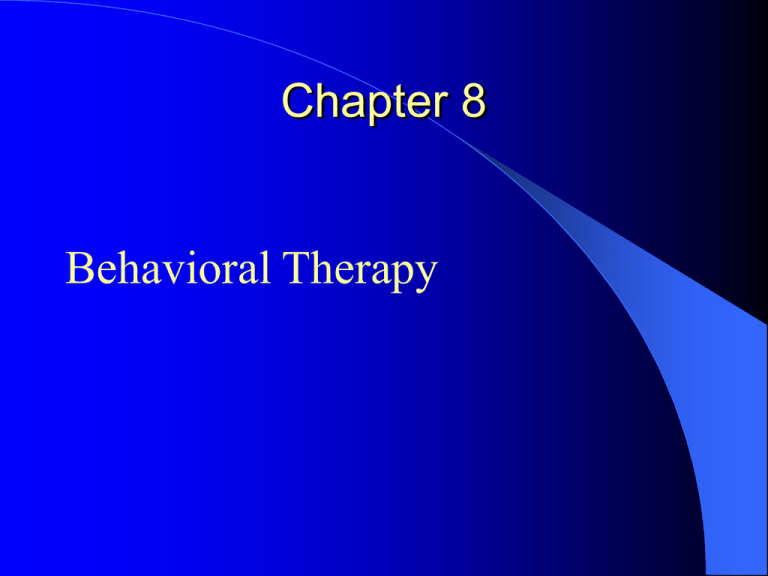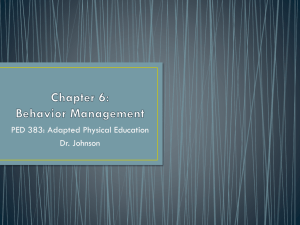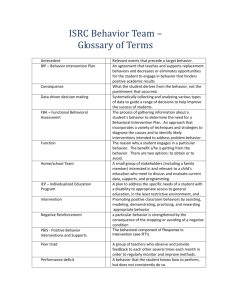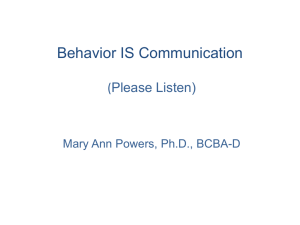Chapter 1
advertisement

Chapter 8 Behavioral Therapy Behavioral Therapy Formulated at the beginning of the 20th century. Focused on how to reinforce, extinguish, or modify a broad range of behaviors. In its infancy (1900’s-1930’s), behaviorism was concerned almost entirely with outward observations. John B. Watson The first major advocate of behaviorism. Worked with a child named Little Albert to demonstrate that human emotions are amenable to being conditioned. Behaviorism in the 1950’s-1960’s B.F.Skinner (1953) – operant conditioning. Joseph Wolpe (1958) – study of respondent (i.e., classical) conditioning. Hans Eysenck (1960) – treatment of abnormal behavior. Albert Bandura (1963) – effects of vicarious learning. John Krumboltz (1966) Credited as one of the major personalities to popularize behaviorism in counseling. Drew upon Bandura’s earlier work and in doing so revolutionized the counseling profession. Categories of Behaviorism By the 1980’s, behavioral approaches to therapy had split into 3 main categories: – Stimulus-response model – Applied behavior analysis – Social-cognitive theory B. F. Skinner Born in 1904 in Susquehanna, Pennsylvania Wanting to be a writer, he moved to Greenwich Village to to live among writers where he discovered the works of Ivan Pavlov, John B. Watson, Bertrand Russell, and Francis Bacon. Soon, he gave up his writings to become a psychologist. Classified as a behavioral determinist View of Human Nature/Personality Assumes that all behavior is learned – whether adaptive or maladaptive. Believes that learning can be effective in changing maladaptive behavior or acquiring new behavior. Rejects the idea that the human personality is composed of traits. Stimulus-Response Model The application of classical conditioning – sometimes called respondent learning or the S-R Model. Learning occurs through the association of two stimuli, also known as the conditioning of involuntary responses. Similarly, many human emotions, such as phobias, arise from paired associations. Counter-conditioning After WWII, behaviorist researcher Mary Cover Jones demonstrated a process known as counter-conditioning that was shown to help people overcome phobic reactions. Once these phobias are learned, new paired associations can be learned to take the place of the phobic reactions. Applied Behavior Analysis Focuses on how individuals operate in the environment. A person is rewarded or punished for actions, thereby learning to discriminate between behaviors. When a behavior is followed closely by a reinforcer, chances increase that the behavior will recur in similar circumstances. The successor to operant conditioning, where a person must be involved as an active participant with the environment for learning to occur. Social Cognitive Behavior People acquire new knowledge and behavior by observing other people – without engaging in the behavior themselves. – without any direct consequences to themselves. Depends on the theory that behavior is based on three separate but interacting regulatory systems: – External stimulus events – External reinforcement – Cognitive mediational processes Learning may occur independently of reinforcement. Roles of the Counselor/Therapist Assist the client in learning new, appropriate ways of acting or to modify or eliminate excessive actions. Active in counseling sessions and functions as a learning specialist for the client. S-R or applied-oriented counselors are direct and prescriptive in offering assistance. Social cognitive learning oriented counselors serve as models. For diagnosis, they describe clients according to the behaviors they display. Goals Focus on changing, modifying, or eliminating behaviors. Set up well-defined therapy goals with clients. Focus on acquiring healthy, constructive ways of acting. 4 Steps to Mutually Agreed on Goals (Blackham & Silberman, 1979) 1. 2. 3. 4. Define the problem. Take a developmental history. Establish specific goals. Determine the best methods for change. Process and Techniques Behavioral therapy is a process. Concentrate on the “here and now” as opposed to the “there and then” of behavior. Behavioral techniques stress the importance of obtaining empirical evidence and scientific support for any technique they use. General Behavioral Techniques Use of Reinforcers Schedules of Reinforcement Shaping Generalization Maintenance Extinction Punishment Use of Reinforcers Events that, when they follow a behavior, increase the probability of the behavior’s recurring. May be either positive or negative. – Positive – considered pleasurable . – Negative – removal of an aversive stimulus. There are no universal positive reinforcers. Schedules of Reinforcement Continuous reinforcement – reinforcement every time the behavior occurs. – Best reinforcement schedule for when a behavior is first being learned. Intermittent reinforcement – reinforcement on an intermittent or inconsistent basis. Schedules of reinforcement operate according to either the number of responses (ratio) or the length of time (interval) between reinforcers. Both ratio and interval schedules are either fixed or variable. Shaping Behavior learned gradually in steps through successive approximation. May break down behavior into manageable units. Generalization The display of behaviors in environments outside where they were originally learned. Indicates that transference into another setting has occurred. Maintenance Being consistent in doing the actions desired without depending on anyone else for support. Accomplished through: – Self-observation – Self-recording Self-monitoring increases client awareness of behavior. Extinction and Punishment Extinction - The elimination of a behavior because of a withdrawal of its reinforcement. Punishment – presenting an aversive stimulus to a situation to suppress or eliminate a behavior. – Usually behaviorists do not use punishment. Specific Behavioral Techniques Behavioral Rehearsal Environmental Planning Systematic Desensitization Assertiveness Training Contingency Contracts Implosive Therapy Flooding Aversive Techniques Covert Sensitization Behavioral Rehearsal Practicing a desired behavior until it is performed the way a client wishes. Process consists of gradually shaping a behavior and getting corrective feedback. Sometimes called role-playing because the client is practicing a new role. Environmental Planning Setting up part of the environment to promote or limit certain behaviors. – Ex. planning a daily schedule to avoid a specific setting and avoid painful memories of a certain place. Systematic Desensitization Designed to help clients overcome anxiety in particular situations. Reciprocal inhibition – a phenomenon based on the idea that people cannot feel anxious and relaxed at the same time. Assertiveness Training A person should feel free to express thoughts and feelings appropriately without feeling undue anxiety. Counterconditioning anxiety and reinforcing assertiveness. Contingency Contracts Contingency contracts spell out the following: – The behaviors to be performed, changed, or discontinued. – Rewards associated with achievement of these goals. – Conditions under which rewards are to be received. Implosive Therapy Desensitizing clients to a situation by having them imagine an anxiety-producing situation that may have dire consequences. – Clients are not taught to relax first. – Should not be used by beginning counselors or with clients who have heart conditions. Flooding The imagined anxiety-producing scene does not have dire consequences. Instead, clients are just overwhelmed with images of these anxiety-producing stimuli. Aversive Techniques Useful when one behavior must be eliminated before another can be taught. – Time-out – Over-correction Covert Sensitization Undesired behavior is eliminated by associating it with unpleasantness. – Used with clients who have problems with smoking, obesity, substance abuse, and sexual deviation. Aversive Stimuli and Effectiveness In the long run, aversive stimuli are usually not effective by themselves for three reasons: – Their negative emotional effects soon disappear. – They may interfere with the learning of desired behaviors. – They may encourage the client to try to escape, which when successful, becomes a positive reinforcer. Furthermore, ethical and legal concerns are associated with aversive techniques. Multicultural and Gender Sensitive Issues Positive: – May help clients be more specific about what they want to do within their subculture and larger cultural groups. Negative: – Counselors must become even more attuned to culture- specific behaviors and how to address them appropriately. Terms and techniques are free of reference to gender. Strengths and Contributions Works well with clients who are predominantly goal- and action-oriented with a need for achievement and results. Good with clients who are interested in changing either a discrete response or a limited number of behaviors. Deals directly with symptoms. Appropriate for a number of disorders. Focuses on the here and now. Variety of techniques available. Based on learning theory. Supported by exceptional research. Popular in institutional settings. Limitations and Criticisms Does not deal well with the total person, just explicit behavior(s). Sometimes applied mechanically. Best demonstrated under controlled conditions that are difficult to replicate. Techniques may be ahead of the theory. Ignores clients’ past histories and unconscious forces. Does not consider developmental stages. Critics of Behavior Therapy Critics charge that behaviorists: – Program clients toward minimum or tolerable levels of behaving. – Reinforce conformity. – Stifle creativity. – Ignore client needs for self-fulfillment, selfactualization, and feelings of self-worth. The Case of Linda: Behavioral Therapy How would you conceptualize this case using behavioral therapy? What would be your treatment plan for this client using a behavioral approach?








